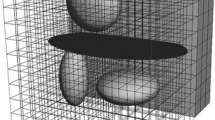Abstract
This paper concerns the dual boundary contour method for solving two-dimensional crack problems. The formulation of the dual boundary contour method is presented. The crack surface is modeled by using continuous quadratic boundary elements. The traction boundary contour equation is applied for traction nodes on one of the crack surfaces and the displacement boundary contour equation is applied for displacement nodes on the opposite crack surface and noncrack boundaries. The direct calculation of the singular integrals arising in displacement BIEs is addressed. These singular integrals are accurately evaluated with potential functions. The singularity subtraction technique for determining the stress intensity factor KI, KII and the T-term are developed for mixed mode conditions. Some two-dimensional examples are presented and numerical results obtained by this approach are in very good agreement with the results of the previous papers.
Similar content being viewed by others
References
Aliabadi, M.H. and Brebbia, C.A. (1993). Advances in Boundary Element Methods of Fracture Mechanics, Elsevier Applied Science, London, New York.
Chen, W.H. and Chen, T.C. (1995). An efficient dual boundary element technique for a two-dimensional fracture problem with multiple cracks. International Journal for Numerical Methods in Engineering 38, 1739-1756.
Civelek, M.B. and Erdogan, F. (1982). Crack problems for a rectangular sheet and an infinite strip. International Journal of Fracture 19, 139-159.
Eischen, J.W. (1987). An improved method for computing the J 2-integral. Engineering Fracture Mechanics 26, 691-700.
Fedelinski, P., Aliabadi, M.H. and Rooke, D.P. (1994). The dual boundary element method: J-integral for dynamic stress intensity factors. International Journal of Fracture 65, 369-381.
Gray, L.J., Martha, L.F. and Ingraffea, A.R. (1990). Hypersingular integrals in boundary element fracture analysis. International Journal for Numerical Methods in Engineering 29, 1135-1158.
Hong, H. and Chen, J. (1988). Derivations of integral equations of elasticity. Journal of Engineering Mechanics 114, 1028-1044.
Leevers, P.S. and Radon, J.C. (1982). Inherent stress biaxiality in various fracture specimen geometries. International Journal of Fracture 19, 311-325.
Mukherjee, Y.X., Mukherjee, S., Shi, X. and Nagarajan, A. (1997). The boundary contour method for three-dimensional linear elasticity with a new quadratic boundary element. Engineering Analysis with Boundary Elements 20, 35-44.
Mukherjee, S. and Mukherjee, Y.X. (1998). The hypersingular boundary contour method for three-dimensional linear elasticity. ASME Journal of Applied Mechanics 65, 300-309.
Nagarajan, A., Lutz, E. D. and Mukherjee, S. (1994). A novel boundary element method for linear elasticity with no numerical integration for 2-D and line integrals for 3-D problems. ASME Journal of Applied Mechanics 61, 264-269.
Nagarajan, A., Mukherjee, S. and Lutz, E.D. (1996). The boundary contour method for three-dimensional linear elasticity. ASME Journal of Applied Mechanics 63, 278-286.
Phan, A.V., Mukherjee, S. and Mayer, J.R.R. (1997). The boundary contour method for two-dimensional linear elasticity with quadratic boundary elements. Computational Mechanics 20, 310-319.
Phan, A.-V., Mukherjee, S. and Mayer, J.R.R. (1998). The hypersingular boundary contour method for two-dimensional linear elasticity. Acta Mechanica 130, 209-225.
Portela, A., Aliabadi, M.H. and Rooke, D.P. (1992a). The dual boundary element method: Effective implementation for crack problems. International Journal for Numerical Methods in Engineering 33, 1269-1278.
Portela, A., Aliabadi, M.H. and Rooke, D.P. (1992b). Dual boundary element analysis of cracked plates: Singularity subtraction technique. International Journal of Fracture 55, 17-28.
Prasad, N.N.V., Aliabadi, M.H. and Rooke, D.P. (1994). The dual boundary element method for thermoelastic crack problems. International Journal of Fracture 66, 255-272.
Tanaka, M., Sladek, V. and Sladek, J. (1994). Regularization techniques applied to boundary element methods. Applied Mechanics Review 47, 457-499.
Tuhkuri, J. (1997). Dual boundary element analysis of closed cracks. International Journal for Numerical Methods in Engineering 40, 2995-3014.
Williams, M.L. (1957). On the stress distribution at the base of a stationary crack. Journal of Applied Mechanics 24, 111-114.
Zhou, S.J., Chen, S.Y. and Sun, S.X. (1997). A novel boundary element method for linear elastic problems. Journal of Mechanical Strength 19, 67-70 (in Chinese).
Zhou, S.J., Cao, Z.Y. and Sun, S.X. (1999a). The traction boundary contour method for linear elasticity. International Journal for Numerical Methods in Engineering (In press).
Zhou, S.J., Sun, X.S. and Cao, Z.Y. (1999b). The boundary contour method based on the equivalent boundary integral equation for two-dimensional linear elasticity. Communication of Numerical Methods in Engineering (In press).
Rights and permissions
About this article
Cite this article
Shenjie, Z., Shuxun, S. & zhiyuan, C. The dual boundary contour method for two-dimensional crack problems. International Journal of Fracture 92, 201–212 (1998). https://doi.org/10.1023/A:1007561523565
Issue Date:
DOI: https://doi.org/10.1023/A:1007561523565




